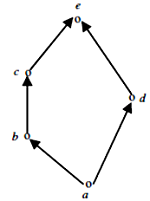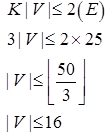PREVIOUS YEAR SOLVED PAPERS - GATE 2017 Shift 2
- Option : A
- Explanation : A Hasse Diagram is called a Lattice, if for every pair of elements there exists a LUB and GLB. In the above Hasse Diagram, LUB and GUB exist for every two elements taken from {a,b,c,d,e}. So, it is already a Lattice. Hence, Minimum number of ordered pairs that need to be added =0
- Option : A
- Explanation : Bottom up parsers in decreasing order of their power: CLR≫ LALR≫ SLR≫ LR (0) The given statements: I. Canonical LR is more powerful than SLR is CORRECT. II. SLR is more powerful than LALR is INCORRECT III. SLR is more powerful than Canonical LR is INCORRECT.
- Option : B
- Explanation : Given L1 and L2 are context free languages and R is a regular language. I. L1 ∪ L2 is context free is CORRECT, context free language are closed under union operation. II. L1 is context free is INCORRECT, context free languages are not closed under complement operation. III. L1 - R is Context free is CORRECT. L1 - R = L1 ∩ R, Context free intersection Regular is always Context free. IV. L1 ∩ L2 is context free is INCORRECT; context free languages are not closed under complement operation.




